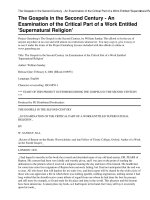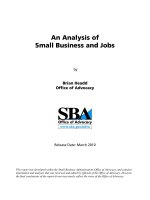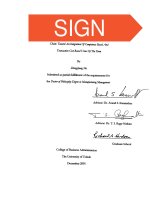Maternal disciplinary practices in south indian mothers an analysis of situational, parent and child variables b
Bạn đang xem bản rút gọn của tài liệu. Xem và tải ngay bản đầy đủ của tài liệu tại đây (223.07 KB, 13 trang )
141
APPENDIX B
STUDY 2 – INTRODUCTION LETTER AND
QUESTIONNAIRE TO MOTHERS
142
Founded 1905
N ATIONAL U NIVERSITY of S INGAPORE
Psychology Programme, Department of Social Work & Psychology,
11, Law Link, Republic of Singapore 117570.
Parvathi N. Sivaraman,
PhD Candidate,
Department of Social Work and Psychology,
National University of Singapore,
Singapore 117570.
Dear Mother,
I am a Ph.D. candidate at the National University of Singapore (NUS) and
am studying parental disciplinary practices. I am interested to study how parents
discipline their children.
To do this I would like to invite mothers to participate in this study by
completing a questionnaire. Please answer the following questions about what
you would do in situations where you may have to discipline your child. The
questions are simple and straightforward and will take no more than 30 minutes
of your time. Please answer honestly. Detailed instructions on how to fill in the
questionnaire follow. All responses will be kept confidential and will be used
strictly for research and academic purposes only.
This project is aimed at achieving a better understanding of the parent-
child relationship and how parents discipline their children. The results from this
project can be used also to obtain insight into how parents treat their children in
the Indian context, with specific reference to Chennai. Such a study has not been
carried out here before. I would greatly appreciate your participation and co-
operation in this regard. However, please be informed that participation is
voluntary and you may choose not to participate. If you have any
questions/clarifications, please do not hesitate to call me at 98413 83877.
Looking forward to your help and the valuable information that only you
can provide.
Yours sincerely,
(Parvathi N.S.) 15 Sept, 2003.
143
PERSONAL PARTICULARS**
1. NAME OF MOTHER :
2. AGE :
3. EDUCATION :
4. CONTACT NUMBER :
5. NUMBER OF CHILDREN :
6. BIRTH ORDER OF THIS CHILD :
7. PRIMARY DISCIPLINARIAN IN THE FAMILY :
** Kindly note that these details are required only to get in touch with you in case the researcher
has any clarifications and also to describe the group of parents studied. Please be assured that
your name or any other details will not be mentioned anywhere in the final report.
144
INSTRUCTIONS
1. Imagine you find your child in each of the following situations presented here.
Please give your response by stating how likely you are to use each of the
possible response techniques stated. That is, how likely are you to use each of
the response techniques in your attempt to discipline your child.
2. Answer the questionnaire keeping in mind the child that brought this
questionnaire home. However, if you have more than one child and both have
received the questionnaire, please answer only for one child. You are free to
choose the child you will answer the questionnaire for.
3. This questionnaire is to be filled in by the mother. In the event that the mother is
not available or is not comfortable with English, please return the questionnaire.
145
EXAMPLE
The following is an example of how to fill in the questionnaire.
Situation 1: You are outside with your family. When you are not looking, your child runs
into a busy street, falls down and starts crying.
1 2 3 4 5
Very little Little Moderate Much Very Much
I) How likely is it that you will use each of the following responses to discipline
your child?
1.Using commands, threats, angry questions scolding or any other form of verbal
discipline to control the child’s behaviour.
1 2 3 4 5
For example, if you circle 5 it indicates that you are ‘very much’ likely to use this method
to discipline your child in this situation.
2.Bribing, pleading, distracting, requesting.
1 2 3 4 5
For example, if you circle 2, it indicates that you are a ‘little’ likely to use this method
with your child in this situation.
II) What are you trying to accomplish in this situation?
1.Try to stop the behaviour immediately and reduce your discomfort.
1 2 3 4 5
For example, if you circle 4,it indicates that it is ‘much’ likely that this is what you are
trying to accomplish in this particular situation.
2.Make the child understand or learn the value of something.
1 2 3 4 5
For example, if you circle 3, it indicates that it is ‘moderately’ likely that you are trying to
accomplish this in this particular situation.
III) On whom/what would you place the responsibility of the situation?
1.How likely is it that your child is responsible for the situation?
1 2 3 4 5
For example, if you circle 5,it indicates that you think it is ‘very much’ likely that your
child is responsible for this particular situation.
2.How likely is it that other circumstances led to such a situation?
1 2 3 4 5
For example, if you circle 2, it indicates that you think it is a ‘little’ likely that other
circumstances are responsible for this situation.
NOTE: This is only an example of how the questionnaire should be filled in. The
actual questionnaire follows.
146
QUESTIONNAIRE
i) You are taking your child for a walk. On the way he/she sees a stray dog and tries to pet
it.
1 2 3 4 5
Very little Little Moderate Much Very Much
I)How likely is it that you will use each of the following responses to discipline your child?
1.Using commands, threats, angry questions, scolding or any other form of verbal discipline to control the
child’s behaviour.
1 2 3 4 5
2.Bribing, pleading, distracting, requesting.
1 2 3 4 5
3.Ignoring, isolating the child, withdrawal of privileges or any other method to induce change in the
child’s behaviour.
1 2 3 4 5
4.Giving an explanation of why the behaviour is inappropriate, undesirable or dangerous, using “if…then”
statements as a way of explanation.
1 2 3 4 5
5.Holding, grabbing the hand or otherwise physically restraining the child. Physical action to keep the
child from doing something.
1 2 3 4 5
6.Slapping, hitting, pinching, pushing, shaking, holding the child with more force than necessary or any
other method of deliberately inflicting physical pain on the child.
1 2 3 4 5
II)What are you trying to accomplish in this situation?
1.Try to stop the behaviour immediately and reduce your discomfort.
1 2 3 4 5
2.Make the child understand or learn the value of something.
1 2 3 4 5
3.Communicate the importance of the relationship that you and your child share and maintain that
relationship harmoniously.
1 2 3 4 5
III)On whom/what would you place the responsibility of the situation?
1.How likely is it that your child is responsible for the situation?
1 2 3 4 5
2.How likely is it that other circumstances led to such a situation?
1 2 3 4 5
147
ii) Your child comes home one day with a sprained ankle. On questioning him/her you
learn that he/she was running down the stairs two at a time and has slipped.
1 2 3 4 5
Very little Little Moderate Much Very Much
I)How likely is it that you will use each of the following responses to discipline your child?
1. Using commands, threats, angry questions, scolding or any other form of verbal discipline to control the
child’s behaviour.
1 2 3 4 5
2. Bribing, pleading, distracting, requesting.
1 2 3 4 5
3. Ignoring, isolating the child, withdrawal of privileges or any other method to induce change in the
child’s behaviour.
1 2 3 4 5
4. Giving an explanation of why the behaviour is inappropriate, undesirable or dangerous, using
“if…then” statements as a way of explanation.
1 2 3 4 5
5. Holding, grabbing the hand or otherwise physically restraining the child. Physical action to keep the
child from doing something.
1 2 3 4 5
6. Slapping, hitting, pinching, pushing, shaking, holding the child with more force than necessary or any
other method of deliberately inflicting physical pain on the child.
1 2 3 4 5
II)What are you trying to accomplish in this situation?
1.Try to stop the behaviour immediately and reduce your discomfort.
1 2 3 4 5
2.Make the child understand or learn the value of something.
1 2 3 4 5
3.Communicate the importance of the relationship that you and your child share and maintain that
relationship harmoniously.
1 2 3 4 5
III)On whom/what would you place the responsibility of the situation?
1.How likely is it that your child is responsible for the situation?
1 2 3 4 5
2.How likely is it that other circumstances led to such a situation?
1 2 3 4 5
148
iii) You are out with your family on the beach. Your child insists on going too deep/playing
too close to the water.
1 2 3 4 5
Very little Little Moderate Much Very Much
I)How likely is it that you will use each of the following responses to discipline your child?
1. Using commands, threats, angry questions, scolding or any other form of verbal discipline to control the
child’s behaviour.
1 2 3 4 5
2. Bribing, pleading, distracting, requesting.
1 2 3 4 5
3. Ignoring, isolating the child, withdrawal of privileges or any other method to induce change in the
child’s behaviour.
1 2 3 4 5
4. Giving an explanation of why the behaviour is inappropriate, undesirable or dangerous, using
“if…then” statements as a way of explanation.
1 2 3 4 5
5. Holding, grabbing the hand or otherwise physically restraining the child. Physical action to keep the
child from doing something.
1 2 3 4 5
6. Slapping, hitting, pinching, pushing, shaking, holding the child with more force than necessary or any
other method of deliberately inflicting physical pain on the child.
1 2 3 4 5
II)What are you trying to accomplish in this situation?
1.Try to stop the behaviour immediately and reduce your discomfort.
1 2 3 4 5
2.Make the child understand or learn the value of something.
1 2 3 4 5
3.Communicate the importance of the relationship that you and your child share and maintain that
relationship harmoniously.
1 2 3 4 5
III)On whom/what would you place the responsibility of the situation?
1.How likely is it that your child is responsible for the situation?
1 2 3 4 5
2.How likely is it that other circumstances led to such a situation?
1 2 3 4 5
149
iv) You are in a high storey building with your child and he/she is leaning out of the
window.
1 2 3 4 5
Very little Little Moderate Much Very Much
I)How likely is it that you will use each of the following responses to discipline your child?
1. Using commands, threats, angry questions, scolding or any other form of verbal discipline to control the
child’s behaviour.
1 2 3 4 5
2. Bribing, pleading, distracting, requesting.
1 2 3 4 5
3. Ignoring, isolating the child, withdrawal of privileges or any other method to induce change in the
child’s behaviour.
1 2 3 4 5
4. Giving an explanation of why the behaviour is inappropriate, undesirable or dangerous, using
“if…then” statements as a way of explanation.
1 2 3 4 5
5. Holding, grabbing the hand or otherwise physically restraining the child. Physical action to keep the
child from doing something.
1 2 3 4 5
6. Slapping, hitting, pinching, pushing, shaking, holding the child with more force than necessary or any
other method of deliberately inflicting physical pain on the child.
1 2 3 4 5
II)What are you trying to accomplish in this situation?
1.Try to stop the behaviour immediately and reduce your discomfort.
1 2 3 4 5
2.Make the child understand or learn the value of something.
1 2 3 4 5
3.Communicate the importance of the relationship that you and your child share and maintain that
relationship harmoniously.
1 2 3 4 5
III)On whom/what would you place the responsibility of the situation?
1.How likely is it that your child is responsible for the situation?
1 2 3 4 5
2.How likely is it that other circumstances led to such a situation?
1 2 3 4 5
150
v) You are having some guests over at your house and your child turns away and refuses to
greet them.
1 2 3 4 5
Very little Little Moderate Much Very Much
I)How likely is it that you will use each of the following responses to discipline your child?
1. Using commands, threats, angry questions, scolding or any other form of verbal discipline to control the
child’s behaviour.
1 2 3 4 5
2.Bribing, pleading, distracting, requesting.
1 2 3 4 5
3. Ignoring, isolating the child, withdrawal of privileges or any other method to induce change in the
child’s behaviour.
1 2 3 4 5
4. Giving an explanation of why the behaviour is inappropriate, undesirable or dangerous, using
“if…then” statements as a way of explanation.
1 2 3 4 5
5. Holding, grabbing the hand or otherwise physically restraining the child. Physical action to keep the
child from doing something.
1 2 3 4 5
6. Slapping, hitting, pinching, pushing, shaking, holding the child with more force than necessary or any
other method of deliberately inflicting physical pain on the child.
1 2 3 4 5
II)What are you trying to accomplish in this situation?
1.Try to stop the behaviour immediately and reduce your discomfort.
1 2 3 4 5
2.Make the child understand or learn the value of something.
1 2 3 4 5
3.Communicate the importance of the relationship that you and your child share and maintain that
relationship harmoniously.
1 2 3 4 5
III)On whom/what would you place the responsibility of the situation?
1.How likely is it that your child is responsible for the situation?
1 2 3 4 5
2.How likely is it that other circumstances led to such a situation?
1 2 3 4 5
151
vi) You have taken your child shopping to a departmental store. There he/she
demands/whines that you buy something for him/her.
1 2 3 4 5
Very little Little Moderate Much Very Much
I)How likely is it that you will use each of the following responses to discipline your child?
1. Using commands, threats, angry questions, scolding or any other form of verbal discipline to control the
child’s behaviour.
1 2 3 4 5
2. Bribing, pleading, distracting, requesting.
1 2 3 4 5
3. Ignoring, isolating the child, withdrawal of privileges or any other method to induce change in the
child’s behaviour.
1 2 3 4 5
4. Giving an explanation of why the behaviour is inappropriate, undesirable or dangerous, using
“if…then” statements as a way of explanation.
1 2 3 4 5
5. Holding, grabbing the hand or otherwise physically restraining the child. Physical action to keep the
child from doing something.
1 2 3 4 5
6. Slapping, hitting, pinching, pushing, shaking, holding the child with more force than necessary or any
other method of deliberately inflicting physical pain on the child.
1 2 3 4 5
II)What are you trying to accomplish in this situation?
1.Try to stop the behaviour immediately and reduce your discomfort.
1 2 3 4 5
2.Make the child understand or learn the value of something.
1 2 3 4 5
3.Communicate the importance of the relationship that you and your child share and maintain that
relationship harmoniously.
1 2 3 4 5
III)On whom/what would you place the responsibility of the situation?
1.How likely is it that your child is responsible for the situation?
1 2 3 4 5
2.How likely is it that other circumstances led to such a situation?
1 2 3 4 5
152
vii) You have been noticing that your child sometimes tends to use inappropriate language
with adults.
1 2 3 4 5
Very little Little Moderate Much Very Much
I)How likely is it that you will use each of the following responses to discipline your child?
1. Using commands, threats, angry questions, scolding or any other form of verbal discipline to control the
child’s behaviour.
1 2 3 4 5
2. Bribing, pleading, distracting, requesting.
1 2 3 4 5
3. Ignoring, isolating the child, withdrawal of privileges or any other method to induce change in the
child’s behaviour.
1 2 3 4 5
4. Giving an explanation of why the behaviour is inappropriate, undesirable or dangerous, using
“if…then” statements as a way of explanation.
1 2 3 4 5
5. Holding, grabbing the hand or otherwise physically restraining the child. Physical action to keep the
child from doing something.
1 2 3 4 5
6. Slapping, hitting, pinching, pushing, shaking, holding the child with more force than necessary or any
other method of deliberately inflicting physical pain on the child.
1 2 3 4 5
II)What are you trying to accomplish in this situation?
1.Try to stop the behaviour immediately and reduce your discomfort.
1 2 3 4 5
2.Make the child understand or learn the value of something.
1 2 3 4 5
3.Communicate the importance of the relationship that you and your child share and maintain that
relationship harmoniously.
1 2 3 4 5
III)On whom/what would you place the responsibility of the situation?
1.How likely is it that your child is responsible for the situation?
1 2 3 4 5
2.How likely is it that other circumstances led to such a situation?
1 2 3 4 5
153
viii) Your child seems to be lying about happenings at school often now that you fear it may
be becoming a habit.
1 2 3 4 5
Very little Little Moderate Much Very Much
I)How likely is it that you will use each of the following responses to discipline your child?
1. Using commands, threats, angry questions, scolding or any other form of verbal discipline to control the
child’s behaviour.
1 2 3 4 5
2. Bribing, pleading, distracting, requesting.
1 2 3 4 5
3.Ignoring, isolating the child, withdrawal of privileges or any other method to induce change in the
child’s behaviour.
1 2 3 4 5
4. Giving an explanation of why the behaviour is inappropriate, undesirable or dangerous, using
“if…then” statements as a way of explanation.
1 2 3 4 5
5. Holding, grabbing the hand or otherwise physically restraining the child. Physical action to keep the
child from doing something.
1 2 3 4 5
6. Slapping, hitting, pinching, pushing, shaking, holding the child with more force than necessary or any
other method of deliberately inflicting physical pain on the child.
1 2 3 4 5
II)What are you trying to accomplish in this situation?
1.Try to stop the behaviour immediately and reduce your discomfort.
1 2 3 4 5
2.Make the child understand or learn the value of something.
1 2 3 4 5
3.Communicate the importance of the relationship that you and your child share and maintain that
relationship harmoniously.
1 2 3 4 5
III)On whom/what would you place the responsibility of the situation?
1.How likely is it that your child is responsible for the situation?
1 2 3 4 5
2.How likely is it that other circumstances led to such a situation?
1 2 3 4 5









![pastoral practices in high asia [electronic resource] agency of 'development' effected by modernisation, resettlement and transformation](https://media.store123doc.com/images/document/14/y/qp/medium_qpp1401382157.jpg)